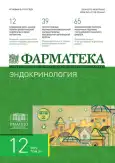Потребление пероральных антикоагулянтов в стационарах Российской Федерации: анализ динамики данных закупок
- Авторы: Матвеев А.В.1, Глаголев С.В.1, Сычев Д.А.1
-
Учреждения:
- Российская медицинская академия непрерывного профессионального образования
- Выпуск: Том 30, № 12 (2023)
- Страницы: 98-106
- Раздел: Оригинальные статьи
- Статья опубликована: 15.11.2023
- URL: https://journals.eco-vector.com/2073-4034/article/view/626057
- DOI: https://doi.org/10.18565/pharmateca.2023.12.98-106
- ID: 626057
Цитировать
Полный текст
Аннотация
Обоснование. Одним из факторов; играющих значимую роль в росте смертности и утрате трудоспособности населения; являются тромбоэмболические осложнения. Основная роль в их лечении и профилактике принадлежит антикоагулянтам; в т.ч. пероральным антикоагулянтам (ПОАК); к которым относятся ривароксабан; апиксабан и дабигатран. Особое значение ПОАК получили в условиях пандемии новой коронавирусной инфекции (COVID-19).
Цель исследования: изучить потребление ПОАК в стационарах РФ с 2017 по 2022 г. и особенности их потребления в условиях пандемии COVID-19.
Методы. В качестве источника данных использовали базы данных ООО «Курсор Маркетинг». Были проанализированы данные о контрактах; заключенных с 01.01.2017 по 31.12.2022. В качестве источника данных по заболеваемости и смертности от COVID-19 использовали данные; опубликованные ВОЗ с 1.03.2020 по 31.12.2022. Расчет потребления проводили на основании данных о DDD (Defined Daily Dose); представленных на сайте Сотрудничающего центра ВОЗ.
Результаты. Всего за период 2017–2022 гг. в базы данных «Курсор» было внесено 57 866 записей; из них 47;38% содержали указание; что в качестве закупаемого лекарственного препарата выступал ривароксабан; в 26;51% – дабигатран и в 26;11% – апиксабан. Отмечено падение числа контрактов в 2022 г.; с 2017 по 2021 г. их число росло; причем для апиксабана прирост был более выражен; а для дабигатрана наименее значителен. Аналогичная динамика наблюдалась и для объема контрактов; выраженного в числе упаковок и DDD; 97% всех контрактов заключались сроком на 1 год. Для всех проанализированных временных рядов было обнаружено наличие сезонности. Число закупаемых упаковок и DDD закупаемого ривароксабана (p<0;05) и апиксабана (p<0;001) коррелировало с показателями новых случаев болезни и смерти от COVID-19.
Заключение. Проблема изучения динамики потребления ПОАК представляет значительный практический интерес. Число запросов на приобретение ПОАК в стационарах РФ увеличивается; а пандемия COVID-19 оказала значимое влияние на структуру закупок.
Матвеев А.В.; Глаголев С.В.; Сычев Д.А. Потребление пероральных антикоагулянтов в стационарах Российской Федерации: анализ динамики данных закупок. Фарматека. 2023;30(12):98-106. doi: 10.18565/pharmateca.2023.12.98-106
Ключевые слова
Полный текст
Об авторах
Александр Васильевич Матвеев
Российская медицинская академия непрерывного профессионального образования
Автор, ответственный за переписку.
Email: matveevav@rmapo.ru
ORCID iD: 0000-0002-6636-3950
SPIN-код: 8518-1320
Scopus Author ID: 37088844200
ResearcherId: 6168-2019
кандидат медицинских наук, доцент кафедры клинической фармакологии и терапии им. акад. Б.Е. Вотчала
Россия, МоскваС. В. Глаголев
Российская медицинская академия непрерывного профессионального образования
Email: matveevav@rmapo.ru
Scopus Author ID: 57193931109
кафедра клинической фармакологии и терапии им. акад. Б.Е. Вотчала
Россия, МоскваД. А. Сычев
Российская медицинская академия непрерывного профессионального образования
Email: matveevav@rmapo.ru
ORCID iD: 0000-0002-4496-3680
SPIN-код: 4525-7556
Scopus Author ID: 7801389135
ResearcherId: 6422-2018
кафедра клинической фармакологии и терапии им. акад. Б.Е. Вотчала
Россия, МоскваСписок литературы
- Strom B.L.; Kimmel S.E.; Hennessy S.; eds. Pharmacoepidemiology. Wiley; 2012. doi: 10.1002/9781119959946.
- WHO International Working Group for Drug Statistics Methodology; WHO Collaborating Centre for Drug Statistics Methodology; WHO Collaborating Centre for Drug Utilization Research and Clinical Pharmacology. Introduction to Drug Utilization Research. WHO; 2003. Accessed October 3; 2023. URL: https://www.who.int/publications/i/item/8280820396
- Чеберда А.Е. Исследования потребления лекарственных средств. Качественная клиническая практика. 2017;(1):42–5. [Cheberda A.E. Drug utilization studies. Quality Clin Pract. 2017;(1):42–5. (In Russ.)].
- Whitworth M.M.; Haase K.K.; Fike D.S.; et al. Utilization and prescribing patterns of direct oral anticoagulants. Int J Gen Med. 2017;10:87. doi: 10.2147/IJGM.S129235.
- Dobesh P.P. Economic Burden of Venous Thromboembolism in Hospitalized Patients. Pharmacother. 2009;29(8):943–53. doi: 10.1592/phco.29.8.943.
- Lim G.B. Milestone 2: Warfarin: from rat poison to clinical use. Nature Publishing Group. Published on-line 2017. doi: 10.1038/nrcardio.2017.172.
- Консенсус экспертов по снижению риска желудочно-кишечных кровотечений у пациентов; получающих оральные антикоагулянты. Терапия. 2021;10(51):23–41. [Expert consensus on reducing the risk of gastrointestinal bleeding in patients receiving oral anticoagulants. Therapy. 2021;10(51):23–41. (In Russ.)].
- Временные методические рекомендации. Профилактика; диагностика и лечение новой коронавирусной инфекции (COVID-19). 8th ed. Министерство здравоохранения Российской Федерации; 2020. URL: https://static-0.minzdrav.gov.ru/system/attachments/attaches/000/051/777/original/030902020_COVID-19_v8.pdf. [Temporary methodological recommendations. Prevention; Diagnosis and Treatment of Emerging Coronavirus Infection (COVID-19). 8th ed. Ministry of Health of the Russian Federation; 2020. (In Russ.)].URL: https://static-0.minzdrav.gov.ru/system/attachments/attaches/000/051/777/original/030902020_COVID-19_v8.pdf
- Клейменова Е.; Отделенов В.; Нигматкулова М. и др. Динамика применения антикоагулянтов в многопрофильном стационаре в 2008–2018 гг. Рациональная фармакотерапия в кардиологии. 2021;17(4):544–51. [Kleymenova E.; Otdelenov V.; Nigmatkulova M.; et al. Dynamics of anticoagulant use in a multidisciplinary hospital in 2008–2018. Rational Pharmacoth Cardiol. 2021;17(4):544–51. (In Russ.)]. doi: 10.20996/1819-6446-2021-08-10.
- Yan V.K.C.; Li H.L.; Wei L.; et al. Evolving Trends in Consumption of Direct Oral Anticoagulants in 65 Countries/Regions from 2008 to 2019. Drugs. 2023;83(4):315–40. doi: 10.1007/s40265-023-01837-0.
- Navar M.; Kolkailah A.A.; Overton R.; et al. Trends in Oral Anticoagulant Use Among 436 864 Patients With Atrial Fibrillation in Community Practice; 2011 to 2020. J Am Heart Associat.: Cardiovasc. Cerebrovasc. Dis. 2022;11(22):26723. doi: 10.1161/JAHA.122.026723.
- Ho K.H.; van Hove M.; Leng G. Trends in anticoagulant prescribing: a review of local policies in English primary care. BMC. Health Serv Res. 2020;20(1):279. doi: 10.1186/s12913-020-5058-1.
- Alkhameys S.; Barrett R. Impact of the COVID-19 pandemic on England’s national prescriptions of oral vitamin K antagonist (VKA) and direct-acting oral anticoagulants (DOACs): an interrupted time series analysis (January 2019–February 2021). Curr Med Res Opin. 2022;38(7):1081–92. doi: 10.1080/03007995.2022.2078100.
- Antonazzo I.C.; Fornari C.; Paoletti O.; et al. COVID-19 Outbreak Impact on Anticoagulants Utilization: An Interrupted Time-Series Analysis Using Health Care Administrative Databases. Thromb Haemost. 2021;121(08):1115–18. doi: 10.1055/a-1523-7658.
- Baybulatova E.A.; Chenkurov M.S.; Korovyako-va E.A.; et al. Direct Oral Anticoagulants Consumption and Expenditure in Covid-19 Pandemic in Russia and Clinical Practice Guidelines for Their Use. Published online 2023. doi: 10.20944/preprints202311.0254.v1.
- DSM Group. Фармацевтический рынок России – 2022 г. 2023. Accessed November 15; 2023. URL: https://dsm.ru/docs/analytics/Annual_report_2023_rus.pdf. [DSM Group. Pharmaceutical Market in Russia – 2022. 2023. Accessed November 15; 2023. (In Russ.)].URL: https://dsm.ru/docs/analytics/Annual_report_2023_rus.pdf
Дополнительные файлы











